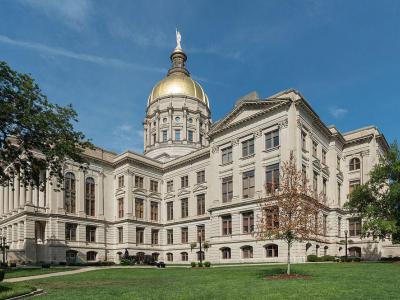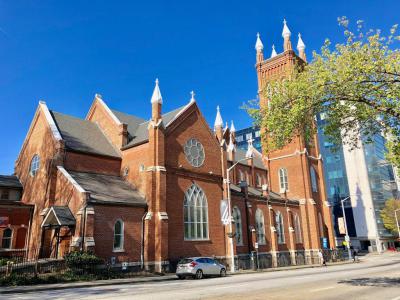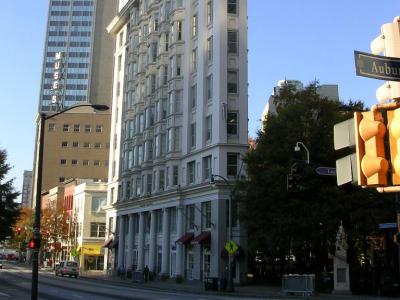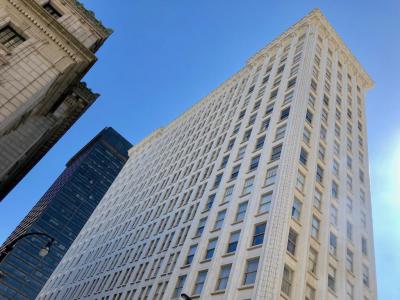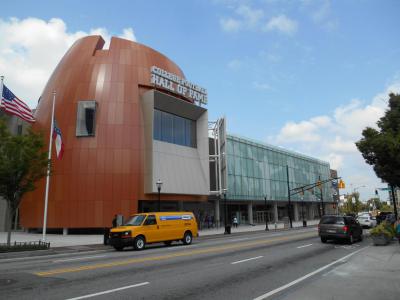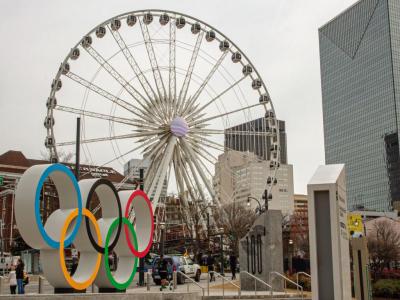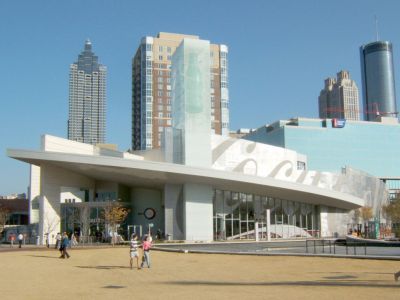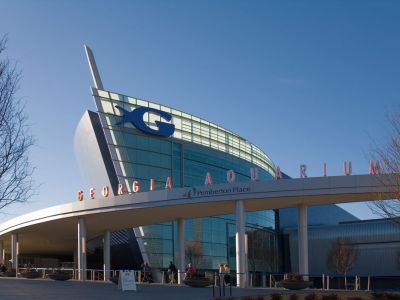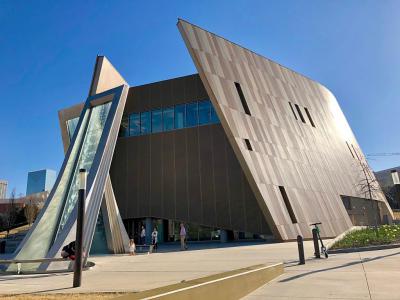Atlanta Downtown Walk (Self Guided), Atlanta
The capital of the U.S. state of Georgia was founded in the mid 1830s, some decade after the first Europeans settled in the area, as the terminus of a major national railroad that provided link between the port of Savannah and the Midwest.
Quite fittingly, the settlement was first known as Terminus, and then Thrasherville. When asked, in 1837, about its future, the railroad's chief engineer said that it would be good "for one tavern, a blacksmith shop, a grocery store, and nothing else". By 1842, however, the town had six buildings and 30 residents and was renamed Marthasville to honor Governor Wilson Lumpkin's daughter Martha.
Later, it was renamed Atlanta after becoming a convergence point among several railroads, spurring its rapid growth. The largest was the Western and Atlantic Railroad, from which the name "Atlanta" is derived, signifying the city's growing reputation as a major transportation hub.
During the American Civil War, Atlanta served a strategically important role for the Confederacy until it was captured in 1864. Almost entirely burnt to the ground during General William T. Sherman's March to the Sea, Atlanta rebounded dramatically in the post-war period and quickly became a national industrial center and the unofficial capital of the "New South". After World War II, the city further established itself as a hub for manufacturing and technology. During the 1950s and 1960s, Atlanta proved instrumental in the American Civil Rights Movement, with Martin Luther King Jr. becoming prominent figure in the movement's leadership.
Perpetually busy, Downtown Atlanta is marked by the presence of governmental facilities such as the Georgia State Capitol, the seat of the State government. The Fairlie–Poplar Historic District, a definitive center point and longtime commercial heart of Atlanta, contains many striking pieces of architecture dating from the late 19th and early 20th centuries. The most famous of them include the Flatiron Building, a wedge-shaped structure from 1897, and the Healey Building, the last major skyscraper erected during the pre-WWI construction boom.
The Olympic Games of 1996 gave the Downtown a significant boost. Centennial Olympic Park, built as a physical memorial to the games, spurred the creation of a tourist district anchored by the Georgia Aquarium and the World of Coca-Cola drawing scores of people to a shiny new area that frequently sprouts various offerings, including festivals and regular lunchtime concerts. Among other prominent attractions in Downtown Atlanta are the CNN Center, the Center for Civil and Human Rights, and the College Football Hall of Fame.
The number of visitors to the "heart of the South" continues to rise steadily year on year, prompted by the round-the-clock, big-city excitement found in a multitude of places. To explore Atlanta's Downtown more closely, at your own pace and in your good time, take this self-guided walking tour.
Quite fittingly, the settlement was first known as Terminus, and then Thrasherville. When asked, in 1837, about its future, the railroad's chief engineer said that it would be good "for one tavern, a blacksmith shop, a grocery store, and nothing else". By 1842, however, the town had six buildings and 30 residents and was renamed Marthasville to honor Governor Wilson Lumpkin's daughter Martha.
Later, it was renamed Atlanta after becoming a convergence point among several railroads, spurring its rapid growth. The largest was the Western and Atlantic Railroad, from which the name "Atlanta" is derived, signifying the city's growing reputation as a major transportation hub.
During the American Civil War, Atlanta served a strategically important role for the Confederacy until it was captured in 1864. Almost entirely burnt to the ground during General William T. Sherman's March to the Sea, Atlanta rebounded dramatically in the post-war period and quickly became a national industrial center and the unofficial capital of the "New South". After World War II, the city further established itself as a hub for manufacturing and technology. During the 1950s and 1960s, Atlanta proved instrumental in the American Civil Rights Movement, with Martin Luther King Jr. becoming prominent figure in the movement's leadership.
Perpetually busy, Downtown Atlanta is marked by the presence of governmental facilities such as the Georgia State Capitol, the seat of the State government. The Fairlie–Poplar Historic District, a definitive center point and longtime commercial heart of Atlanta, contains many striking pieces of architecture dating from the late 19th and early 20th centuries. The most famous of them include the Flatiron Building, a wedge-shaped structure from 1897, and the Healey Building, the last major skyscraper erected during the pre-WWI construction boom.
The Olympic Games of 1996 gave the Downtown a significant boost. Centennial Olympic Park, built as a physical memorial to the games, spurred the creation of a tourist district anchored by the Georgia Aquarium and the World of Coca-Cola drawing scores of people to a shiny new area that frequently sprouts various offerings, including festivals and regular lunchtime concerts. Among other prominent attractions in Downtown Atlanta are the CNN Center, the Center for Civil and Human Rights, and the College Football Hall of Fame.
The number of visitors to the "heart of the South" continues to rise steadily year on year, prompted by the round-the-clock, big-city excitement found in a multitude of places. To explore Atlanta's Downtown more closely, at your own pace and in your good time, take this self-guided walking tour.
How it works: Download the app "GPSmyCity: Walks in 1K+ Cities" from Apple App Store or Google Play Store to your mobile phone or tablet. The app turns your mobile device into a personal tour guide and its built-in GPS navigation functions guide you from one tour stop to next. The app works offline, so no data plan is needed when traveling abroad.
Atlanta Downtown Walk Map
Guide Name: Atlanta Downtown Walk
Guide Location: USA » Atlanta (See other walking tours in Atlanta)
Guide Type: Self-guided Walking Tour (Sightseeing)
# of Attractions: 11
Tour Duration: 2 Hour(s)
Travel Distance: 3.3 Km or 2.1 Miles
Author: brian
Sight(s) Featured in This Guide:
Guide Location: USA » Atlanta (See other walking tours in Atlanta)
Guide Type: Self-guided Walking Tour (Sightseeing)
# of Attractions: 11
Tour Duration: 2 Hour(s)
Travel Distance: 3.3 Km or 2.1 Miles
Author: brian
Sight(s) Featured in This Guide:
- Georgia State Capitol
- Catholic Shrine of the Immaculate Conception
- Flatiron Building
- Healey Building and Fairlie–Poplar Historic District
- CNN Center
- College Football Hall of Fame
- Centennial Olympic Park
- SkyView Ferris Atlanta
- World of Coca-Cola
- Georgia Aquarium
- National Center for Civil and Human Rights
1) Georgia State Capitol
An architectural and historical gem in the heart of Downtown Atlanta, Georgia's State Capitol stands out proudly with its gold-plated dome capped by a statue of Miss Freedom, while the equally impressive, regal-looking interior has marble floors, grand staircases and pillars that exude a sense of government power. On the second floor, you can find the offices of the governor, lieutenant governor, and secretary of state, while the third floor houses the chambers for the General Assembly. The fourth floor is home to visitors' galleries overlooking the legislative chambers and a free museum that showcases Georgia's history, including nature, people, government, state politics, and the building itself.
During the legislative session from January through April, the State Capitol becomes a bustling hub of activity, with crowds of lobbyists gathered 'around the rope lines' leading into the House and Senate cloakrooms. If your schedule allows, be sure to visit the galleries to observe the impressive legislative chambers, whether they are in session or not.
Why You Should Visit:
Great place for those with an interest in Georgia history, politics, or buildings with golden domes.
Surrounded by lushly landscaped grounds with large hardwoods that are home to several varieties of hawks.
Tip:
Start on the fourth floor, where the museum is, and work your way down to the main level.
Take a photo ID or copy of passport, as you need it for entrance.
During the legislative session from January through April, the State Capitol becomes a bustling hub of activity, with crowds of lobbyists gathered 'around the rope lines' leading into the House and Senate cloakrooms. If your schedule allows, be sure to visit the galleries to observe the impressive legislative chambers, whether they are in session or not.
Why You Should Visit:
Great place for those with an interest in Georgia history, politics, or buildings with golden domes.
Surrounded by lushly landscaped grounds with large hardwoods that are home to several varieties of hawks.
Tip:
Start on the fourth floor, where the museum is, and work your way down to the main level.
Take a photo ID or copy of passport, as you need it for entrance.
2) Catholic Shrine of the Immaculate Conception
A paragon of simple beauty, Downtown's Catholic Shrine may lack the grandeur and scale of a Catholic cathedral, but nonetheless does not shy in serenity and majesty. Whether or not you are a Catholic, this church, named after Murillo's painting "Immaculate Conception", should be on your list of attractions to visit, especially if you are in the Downtown area and enjoy history. It is extremely welcoming and genuinely friendly to people from all walks of life and every background.
Located near the Georgia State Capitol and almost next door to the Central Presbyterian Church, the Shrine, completed and dedicated in 1873, is one of Georgia's oldest churches that was fortunate to survive the shock of Civil War (or 'The War Between the States', according to a nearby plaque).
The main building has only one large interior room, but within it you will find the sides flanked with gorgeous stained glass windows and paintings describing the Passion of Christ, while the ceiling is adorned with eight large colorful portraits of Catholic saints. However, the main spotlight as you walk in is the ornate main altar. Absorb the serene atmosphere as you slowly walk toward it to admire its detailed beauty!
Tip:
Try to go on a sunny day with the light streaming through the stained glass windows.
Located near the Georgia State Capitol and almost next door to the Central Presbyterian Church, the Shrine, completed and dedicated in 1873, is one of Georgia's oldest churches that was fortunate to survive the shock of Civil War (or 'The War Between the States', according to a nearby plaque).
The main building has only one large interior room, but within it you will find the sides flanked with gorgeous stained glass windows and paintings describing the Passion of Christ, while the ceiling is adorned with eight large colorful portraits of Catholic saints. However, the main spotlight as you walk in is the ornate main altar. Absorb the serene atmosphere as you slowly walk toward it to admire its detailed beauty!
Tip:
Try to go on a sunny day with the light streaming through the stained glass windows.
3) Flatiron Building
Built in 1897, Atlanta's Flatiron Building is one of the oldest buildings in the city and is known for its distinctive triangular shape that resembles the famous Flatiron Building in New York City. The building's design was influenced by the Chicago School of Architecture, with a steel frame and terra cotta cladding.
Originally named the English-American Building, the Flatiron Building has had several uses over the years, including as a hotel, office building, and currently as a mixed-use space that includes offices, retail stores, and restaurants. The building was added to the National Register of Historic Places in 1983.
Today, the Flatiron Building is a popular attraction for visitors to Atlanta, with its unique architecture and prime location at the intersection of Peachtree Street and Broad Street. The building's exterior has been restored to its original condition, with the distinctive terra cotta tiles, arched windows, and ornate details that make it a standout feature of the downtown skyline.
Visitors can also explore the building's interior, which features a beautiful marble staircase and vintage elevator. The Flatiron Building is also home to several popular restaurants, including a rooftop bar that offers stunning views of the city.
Overall, the Flatiron Building is a must-see for architecture enthusiasts and anyone interested in exploring the history and culture of Atlanta.
Originally named the English-American Building, the Flatiron Building has had several uses over the years, including as a hotel, office building, and currently as a mixed-use space that includes offices, retail stores, and restaurants. The building was added to the National Register of Historic Places in 1983.
Today, the Flatiron Building is a popular attraction for visitors to Atlanta, with its unique architecture and prime location at the intersection of Peachtree Street and Broad Street. The building's exterior has been restored to its original condition, with the distinctive terra cotta tiles, arched windows, and ornate details that make it a standout feature of the downtown skyline.
Visitors can also explore the building's interior, which features a beautiful marble staircase and vintage elevator. The Flatiron Building is also home to several popular restaurants, including a rooftop bar that offers stunning views of the city.
Overall, the Flatiron Building is a must-see for architecture enthusiasts and anyone interested in exploring the history and culture of Atlanta.
4) Healey Building and Fairlie–Poplar Historic District
Often dubbed "The Queen of Atlanta", the Healey Building in the Fairlie–Poplar District was the last major skyscraper erected in the Capital of the South during the pre-WWI construction boom. On August 8, 1977, it was listed on the National Register of Historic Places, and since 1987 and has enjoyed local landmark status as well. 2001 saw the upper floors converted into condominiums, while the lower floors continue to be the home of galleries, shops, and restaurants. Anyone wanting to see a great example of adaptive re-use and rehabilitation of a landmark will enjoy a visit.
Part of downtown Atlanta's central business district, the Fairlie–Poplar Historic District is named for the two streets that cross at its center: northeast-only Fairlie and southeast-only Poplar. With smaller city blocks than the rest of the city (about half by half), and streets running at a 40° diagonal, Fairlie–Poplar contains many commercial and office buildings from the late 19th and early 20th centuries, including local interpretations of prevailing national architectural styles: Chicago, Renaissance Revival, Neoclassical, Commercial, Art Deco, Georgian Revival, and Victorian.
The district's buildings also represent the shift in building technology from load-bearing masonry and timber walls to steel and concrete framing.
Overall, the Poplar is a beautiful and unique area to explore in Atlanta, offering a glimpse into the city's rich history and architectural heritage.
Part of downtown Atlanta's central business district, the Fairlie–Poplar Historic District is named for the two streets that cross at its center: northeast-only Fairlie and southeast-only Poplar. With smaller city blocks than the rest of the city (about half by half), and streets running at a 40° diagonal, Fairlie–Poplar contains many commercial and office buildings from the late 19th and early 20th centuries, including local interpretations of prevailing national architectural styles: Chicago, Renaissance Revival, Neoclassical, Commercial, Art Deco, Georgian Revival, and Victorian.
The district's buildings also represent the shift in building technology from load-bearing masonry and timber walls to steel and concrete framing.
Overall, the Poplar is a beautiful and unique area to explore in Atlanta, offering a glimpse into the city's rich history and architectural heritage.
5) CNN Center (must see)
The CNN Center is a must-visit destination in Atlanta, Georgia for anyone interested in news and media. As the world headquarters for CNN, the center offers a behind-the-scenes look at how news is produced and broadcast to a global audience. Visitors can take a guided tour of the studios and control rooms, see live news broadcasts in action, and even try their hand at being a news anchor in a mock studio.
The atrium escalator being used to transport visitors on has been listed in the Guinness Book of World Records as the longest freestanding (supported only at the ends) escalator in the world! The center also features a large food court, retail shops, and a giant screen showing breaking news and live events. Whether you're a news junkie or just curious about how it all works, the CNN Center is a fascinating and educational experience for visitors of all ages.
Why You Should Visit:
Gives a better behind-the-scenes idea of how 'news' are made and what goes on at CNN, and how many people are actually involved in the process, too.
There are paid 50-minute guided tours highlighting the CNN broadcasting and with a VIP tour, so you can walk right through the newsroom among people working and take all the pics you want.
Tip:
Perfect place to get your food and drink on before events at Philips Arena and the Georgia Dome (prices are half as much).
The atrium escalator being used to transport visitors on has been listed in the Guinness Book of World Records as the longest freestanding (supported only at the ends) escalator in the world! The center also features a large food court, retail shops, and a giant screen showing breaking news and live events. Whether you're a news junkie or just curious about how it all works, the CNN Center is a fascinating and educational experience for visitors of all ages.
Why You Should Visit:
Gives a better behind-the-scenes idea of how 'news' are made and what goes on at CNN, and how many people are actually involved in the process, too.
There are paid 50-minute guided tours highlighting the CNN broadcasting and with a VIP tour, so you can walk right through the newsroom among people working and take all the pics you want.
Tip:
Perfect place to get your food and drink on before events at Philips Arena and the Georgia Dome (prices are half as much).
6) College Football Hall of Fame (must see)
If you are into college football or just want to gain a better understanding of the sport, this is a great place to kill an hour or two taking it all in. After being founded by the National Football Foundation in 1951, to immortalize the players and coaches of college football, the Hall was decided to be moved to Atlanta in 2009. The new building broke ground on January 28, 2013, and on August 23, 2014 the $68.5-million museum opened its doors for the first time.
Sections of the structure are reminiscent of a football in shape. The facility contains approximately 50,000 square feet (4,600 m2) of exhibit and event space. They have plenty of impressive artifacts on display and informative/interactive exhibits, along with an authentic 45-yard indoor football field in the middle of it all, where you can kick a ball or throw a touch pass.
Additional reasons for a visit are the huge welcoming wall with helmets of every college team in the country, the displays of football equipment and accessories through the years, the gift shop stocked with lots to choose from, and the 3rd-floor Hall of Fame itself, which is a large circle of glass columns with etched names of the inductees. As of 2018, there are 997 players and 217 coaches enshrined in the Hall, representing 308 schools. Thirteen players, two coaches and one inanimate object (the Goodyear Blimp) were slated for induction in 2019.
Everyone working here is super helpful and will point out a few things that you might not discover on your own – things that people of all ages can enjoy!
Sections of the structure are reminiscent of a football in shape. The facility contains approximately 50,000 square feet (4,600 m2) of exhibit and event space. They have plenty of impressive artifacts on display and informative/interactive exhibits, along with an authentic 45-yard indoor football field in the middle of it all, where you can kick a ball or throw a touch pass.
Additional reasons for a visit are the huge welcoming wall with helmets of every college team in the country, the displays of football equipment and accessories through the years, the gift shop stocked with lots to choose from, and the 3rd-floor Hall of Fame itself, which is a large circle of glass columns with etched names of the inductees. As of 2018, there are 997 players and 217 coaches enshrined in the Hall, representing 308 schools. Thirteen players, two coaches and one inanimate object (the Goodyear Blimp) were slated for induction in 2019.
Everyone working here is super helpful and will point out a few things that you might not discover on your own – things that people of all ages can enjoy!
7) Centennial Olympic Park (must see)
Built by the Atlanta Committee for the Olympic Games (ACOG) as part of the infrastructure improvements for the Centennial 1996 Summer Olympics, this park plays host to millions of visitors a year as well as several events, including a summer popular music concert series (Wednesday WindDown) and an annual Independence Day concert and fireworks display. It covers 21 acres (85,000 sq m) and can be divided into The Great Lawn, Centennial Plaza, and the Visitor Center.
A key feature is the interactive Fountain of Rings which features computer-controlled lights and 251 jets of water synchronized with music played from speakers. An important formal architectural landmark that is also a fun and playful space, the computer-controlled fountain concept has since been replicated in other urban designs such as Toronto's Dundas Square and in commercial uses such as the Bellagio Fountains at the Bellagio Hotel & Casino in Las Vegas, Nevada.
Apart from the light towers reminiscent of classical Greek marker columns, the fountain area is surrounded by flags representing the host countries of each Summer Olympics preceding the 1996 games. Scattered throughout are also several pieces of sculpture, including a statue of Pierre de Coubertin, father of the modern Olympic movement.
The park has shows at the fountain four times daily (12:30/3:30/6:30/9pm). In 2013, SkyView Atlanta, a 200-foot (61-m) Ferris wheel with 42 air-conditioned cars and great views of the park and surroundings, debuted across the street.
Why You Should Visit:
Relaxing environment, wide range of outdoor activities, clean restrooms, nice atmosphere.
Visitors can enjoy picnics, play frisbee or other sports, or simply relax in the sun.
City views from the main lawn and nice shade by the waterfalls and rocks.
The fountains are great fun for kids and a favorite backdrop for photographers.
Tip:
If adventurous wear your swimming suit and cool off in the fountains. Your visit should otherwise start at the Visitor Information Center (pick up a walking tour map, or get the online version for your phone).
A key feature is the interactive Fountain of Rings which features computer-controlled lights and 251 jets of water synchronized with music played from speakers. An important formal architectural landmark that is also a fun and playful space, the computer-controlled fountain concept has since been replicated in other urban designs such as Toronto's Dundas Square and in commercial uses such as the Bellagio Fountains at the Bellagio Hotel & Casino in Las Vegas, Nevada.
Apart from the light towers reminiscent of classical Greek marker columns, the fountain area is surrounded by flags representing the host countries of each Summer Olympics preceding the 1996 games. Scattered throughout are also several pieces of sculpture, including a statue of Pierre de Coubertin, father of the modern Olympic movement.
The park has shows at the fountain four times daily (12:30/3:30/6:30/9pm). In 2013, SkyView Atlanta, a 200-foot (61-m) Ferris wheel with 42 air-conditioned cars and great views of the park and surroundings, debuted across the street.
Why You Should Visit:
Relaxing environment, wide range of outdoor activities, clean restrooms, nice atmosphere.
Visitors can enjoy picnics, play frisbee or other sports, or simply relax in the sun.
City views from the main lawn and nice shade by the waterfalls and rocks.
The fountains are great fun for kids and a favorite backdrop for photographers.
Tip:
If adventurous wear your swimming suit and cool off in the fountains. Your visit should otherwise start at the Visitor Information Center (pick up a walking tour map, or get the online version for your phone).
8) SkyView Ferris Atlanta
If you want to capture the essence of Atlanta in one go, look no further than here! SkyView Atlanta, a “one-and-done” destination, will provide an thrilling panoramic view of the city and the surrounding metropolitan area, offering a fresh perspective – atop a 200-foot-tall Ferris wheel – which is especially valuable if you are not afforded access to the city's towering structures.
Situated almost 20 stories high above Centennial Olympic Park and surrounded by other local attractions (including the Georgia Aquarium, the Tabernacle, or the World of Coca-Cola), this wheel boasts of 42 lavish, climate-controlled gondolas, with each able to accommodate up to 6 people. For those seeking an elevated, "private" experience, one can pre-book a VIP gondola, providing all the frills including Ferrari-style seats, tinted windows, clear glass floor, and a longer flight time. The wait time and ride duration are reasonable, and in addition to the breathtaking view, this attraction is great for families, couples, and cost-effective – unless you have a fear of heights.
Moreover, do not miss the light show at night! Check for Groupon and other local offers before purchasing on-site tickets to save on the cost. This attraction is the perfect complement to your downtown adventure, providing a fun experience for all ages.
Situated almost 20 stories high above Centennial Olympic Park and surrounded by other local attractions (including the Georgia Aquarium, the Tabernacle, or the World of Coca-Cola), this wheel boasts of 42 lavish, climate-controlled gondolas, with each able to accommodate up to 6 people. For those seeking an elevated, "private" experience, one can pre-book a VIP gondola, providing all the frills including Ferrari-style seats, tinted windows, clear glass floor, and a longer flight time. The wait time and ride duration are reasonable, and in addition to the breathtaking view, this attraction is great for families, couples, and cost-effective – unless you have a fear of heights.
Moreover, do not miss the light show at night! Check for Groupon and other local offers before purchasing on-site tickets to save on the cost. This attraction is the perfect complement to your downtown adventure, providing a fun experience for all ages.
9) World of Coca-Cola (must see)
Prepare to have your taste buds tickled and your senses stimulated at this classic Atlanta tourist destination that is a must-visit for anyone looking to understand the global impact of Coca-Cola on people's lives. For a very reasonable admission fee, you can enjoy a leisurely 2-hour exploration of the museum's exhibits spread over two floors. Upon arrival, you'll be greeted with a free can of Coke and an introduction to the historical artifacts of the company, as well as a video – essentially a long Coca-Cola ad – which acts as a nice segway into the next portion – the entrance into the main hall.
On the first floor, you'll get to explore "The Vault" (rumored to hold the physical copy of the top-secret Coca-Cola recipe), the "Milestones of Refreshment" walk-through exhibit, where you'll learn about the company's history, see the manufacturing process at "Bottle Works," and even take a selfie with the ever-jovial Polar Bear mascot. On the second floor, you'll be treated with a 4D theater that offers a wild roller-coaster-like sensation as the seats move in sync with the short film, plus various galleries, massive gift shop, and of course the most exciting portion: the Tasting Room!
In the Tasting Room, you can sample over 100 different flavors of drinks from all over the world, produced under Coca-Cola license, as well as some drink specials from the bar. A very cool way to end the tour!
Why You Should Visit:
Tons of Coca-Cola paraphernalia and memorabilia, and you are given a virtually unlimited supply of Coca-Cola beverages from around the world to taste (naturally, you won't find any Pepsi drinks or merchandise here!).
Tip:
Try to book online or buy the City Pass to jump at least one or two queues for entrance.
On the first floor, you'll get to explore "The Vault" (rumored to hold the physical copy of the top-secret Coca-Cola recipe), the "Milestones of Refreshment" walk-through exhibit, where you'll learn about the company's history, see the manufacturing process at "Bottle Works," and even take a selfie with the ever-jovial Polar Bear mascot. On the second floor, you'll be treated with a 4D theater that offers a wild roller-coaster-like sensation as the seats move in sync with the short film, plus various galleries, massive gift shop, and of course the most exciting portion: the Tasting Room!
In the Tasting Room, you can sample over 100 different flavors of drinks from all over the world, produced under Coca-Cola license, as well as some drink specials from the bar. A very cool way to end the tour!
Why You Should Visit:
Tons of Coca-Cola paraphernalia and memorabilia, and you are given a virtually unlimited supply of Coca-Cola beverages from around the world to taste (naturally, you won't find any Pepsi drinks or merchandise here!).
Tip:
Try to book online or buy the City Pass to jump at least one or two queues for entrance.
10) Georgia Aquarium (must see)
Since it bills itself as the largest in the world, the Georgia Aquarium should definitely be on most visitors' lists of things to do while in Atlanta. It's a well designed aquarium with exhibits broken down by habitat and the only water tank big enough to accommodate several whale sharks, which is reason alone to buy tickets, especially if you've never seen them live.
Of course, while the whale sharks are the star attraction, the Aquarium has so much more! Their many smaller tanks feature an array of interesting species with everything from freshwater fish to penguins, otters, and beluga whales. Sea lion and dolphin shows are a part of the admission fee, but just watching the several species of jellyfish in their individual tanks can keep you mesmerized for hours as they move gracefully up and down with their flowing hairlike tentacles.
Everything is beautifully presented with large walls of thick glass so visitors can feel close to the sea life, separated by mere inches from the most amazing coral and fish, both large and small. In some places aquarium windows glitter with fish moving overhead, and at the entrance there is even a watery wall of schooling fish reflecting changing shades of blue light.
Why You Should Visit:
To experience all the world's major marine ecosystems in a single place – mostly via spectacular large displays and sometimes pop-up viewing stations/crawl spaces. From the Arctic waters where you'll see beluga whales and penguins to tropical seas where there is everything from seahorses to stingrays and sharks.
Tip:
Buy your tickets online as it is a better deal – some discounts there cannot be purchased in person.
Consider paying a little extra to do the backstage tour – well worth the money and great for all ages.
Of course, while the whale sharks are the star attraction, the Aquarium has so much more! Their many smaller tanks feature an array of interesting species with everything from freshwater fish to penguins, otters, and beluga whales. Sea lion and dolphin shows are a part of the admission fee, but just watching the several species of jellyfish in their individual tanks can keep you mesmerized for hours as they move gracefully up and down with their flowing hairlike tentacles.
Everything is beautifully presented with large walls of thick glass so visitors can feel close to the sea life, separated by mere inches from the most amazing coral and fish, both large and small. In some places aquarium windows glitter with fish moving overhead, and at the entrance there is even a watery wall of schooling fish reflecting changing shades of blue light.
Why You Should Visit:
To experience all the world's major marine ecosystems in a single place – mostly via spectacular large displays and sometimes pop-up viewing stations/crawl spaces. From the Arctic waters where you'll see beluga whales and penguins to tropical seas where there is everything from seahorses to stingrays and sharks.
Tip:
Buy your tickets online as it is a better deal – some discounts there cannot be purchased in person.
Consider paying a little extra to do the backstage tour – well worth the money and great for all ages.
11) National Center for Civil and Human Rights (must see)
Opened to the public in 2014 and located in the same downtown plaza as the Georgia Aquarium and the World of Coca-Cola building, the Center for Civil and Human Rights boasts stunning architecture and highlights the central role the city of Atlanta has played in the civil and human rights movement.
The Center hosts a number of exhibitions, both permanent and temporary, that not only tell the history of the civil rights movement in the U.S., but how that period is related to more contemporary human rights struggles around the world. During the development phase, it was determined that the average visitor would be more familiar with events in Sudan or the Middle East than they would with others in e.g. Selma, Alabama, and that civil rights history alone would not be enough to sustain the facility.
In early 2014, the New York Times named the Center as one of the biggest reasons to visit Atlanta, along with the then-soon-to-open Atlanta Streetcar and other new attractions. Do not leave the city without spending time here!
The Center hosts a number of exhibitions, both permanent and temporary, that not only tell the history of the civil rights movement in the U.S., but how that period is related to more contemporary human rights struggles around the world. During the development phase, it was determined that the average visitor would be more familiar with events in Sudan or the Middle East than they would with others in e.g. Selma, Alabama, and that civil rights history alone would not be enough to sustain the facility.
In early 2014, the New York Times named the Center as one of the biggest reasons to visit Atlanta, along with the then-soon-to-open Atlanta Streetcar and other new attractions. Do not leave the city without spending time here!
Walking Tours in Atlanta, Georgia
Create Your Own Walk in Atlanta
Creating your own self-guided walk in Atlanta is easy and fun. Choose the city attractions that you want to see and a walk route map will be created just for you. You can even set your hotel as the start point of the walk.
Centennial Olympic Park
The Centennial Olympic Park in Atlanta is a sprawling urban oasis, covering approximately 21 acres. It was created as a central gathering place for the Centennial Summer Olympic Games held in Georgia in 1996. In the years following the Games, the area witnessed commercial development resulting in a variety of attractions and amenities suitable for visitors of all ages.
One of the notable sites... view more
Tour Duration: 2 Hour(s)
Travel Distance: 1.6 Km or 1 Miles
One of the notable sites... view more
Tour Duration: 2 Hour(s)
Travel Distance: 1.6 Km or 1 Miles
"Gone with the Wind" Walking Tour
Atlanta does “give a damn” about Gone With The Wind. There is a number of museums and sites in the city that commemorate one of America's all-time classic stories. Although released as far back as the 1930s, both Margaret Mitchell's award-winning novel and the film that followed shortly still inspire curiosity about and are equally celebrated in Atlanta.
The first port of call for... view more
Tour Duration: 2 Hour(s)
Travel Distance: 5.0 Km or 3.1 Miles
The first port of call for... view more
Tour Duration: 2 Hour(s)
Travel Distance: 5.0 Km or 3.1 Miles
Atlanta Midtown Walking Tour
A commercial core of Atlanta, Midtown is also a residential neighborhood, anchored by a series of high-rising office buildings, condominiums, and hotels. The exact geographical extent of the district is uncertain due to the varied definitions applied by people, authorities and businesses involved. Although its boundaries have never been clearly defined, Midtown Atlanta basically comprises the area... view more
Tour Duration: 2 Hour(s)
Travel Distance: 3.4 Km or 2.1 Miles
Tour Duration: 2 Hour(s)
Travel Distance: 3.4 Km or 2.1 Miles
Martin Luther King Walking Tour
Martin Luther King Junior holds a special place in the hearts of many, and his legacy is deeply intertwined with Atlanta, Georgia. The most recognized spokesperson and leader of the Civil Rights Movement in the late 1950s and '60s, he was a Baptist Minister who used non-violent and civil disobedience tactics to advance the civil rights cause.
Though Doctor King had his share of critics,... view more
Tour Duration: 1 Hour(s)
Travel Distance: 1.0 Km or 0.6 Miles
Though Doctor King had his share of critics,... view more
Tour Duration: 1 Hour(s)
Travel Distance: 1.0 Km or 0.6 Miles
The Most Popular Cities
/ view all



